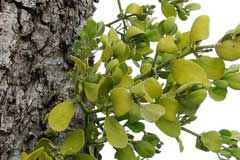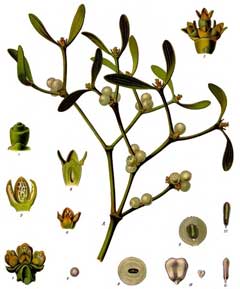 |
|
commons.wikimedia.org/wiki/User:Loadmaster |
 |
| commons.wikimedia.org/wiki/File:Koeh-281.jpg |
Translate this page:
Summary
Physical Characteristics

 Viscum album is an evergreen Shrub growing to 1 m (3ft 3in) by 1 m (3ft 3in).
Viscum album is an evergreen Shrub growing to 1 m (3ft 3in) by 1 m (3ft 3in).
See above for USDA hardiness. It is hardy to UK zone 7. It is in leaf all year, in flower from February to April, and the seeds ripen from November to December. The species is dioecious (individual flowers are either male or female, but only one sex is to be found on any one plant so both male and female plants must be grown if seed is required). . The plant is not self-fertile.
Suitable for: light (sandy), medium (loamy) and heavy (clay) soils. Suitable pH: mildly acid, neutral and basic (mildly alkaline) soils. It can grow in semi-shade (light woodland) or no shade. It prefers moist soil.
UK Hardiness Map
US Hardiness Map
Synonyms
Stelin album Bubani
Plant Habitats
Woodland Garden Sunny Edge; Dappled Shade; Shady Edge;
Edible Uses
Edible Parts: Fruit
Edible Uses:
The ripe fruit is edible[272]. Some caution is advised, see notes above on toxicity[K].
References More on Edible Uses
Medicinal Uses
Plants For A Future can not take any responsibility for any adverse effects from the use of plants. Always seek advice from a professional before using a plant medicinally.
Antianxiety Anticonvulsant Antidiarrhoeal Antispasmodic Cardiac Cytostatic Diuretic Epilepsy
Hypotensive Narcotic Nervine Stimulant Tonic Vasodilator
Mistletoe is chiefly used to lower blood pressure and heart rate, ease anxiety and promote sleep. In low doses it can also relieve panic attacks and headaches, and also improves the ability to concentrate[254]. The plant's efficacy as an anticancer treatment has been subject to a significant amount of research - there is no doubt that certain constituents of the plant , especially the viscotoxins, exhibit an anticancer activity but the value of the whole plant in cancer treatment is not fully accepted[254]. It is said that the constituents of mistletoe vary according to the host plant it is growing on - that found on oak trees is said to be superior[238]. Because of the potential side effects, this plant should only be used internally under the guidance of a skilled practitioner. Using the plant internally can provoke intolerant reactions to certain substances[7]. The leaves and young twigs contain several medically active compounds[279]. They are antispasmodic, cardiac, cytostatic, diuretic, hypotensive, narcotic, nervine, stimulant, tonic and vasodilator[4, 7, 19, 21, 46, 66, 165, 238, 279]. They are harvested just before the berries form and are dried for later use[4]. Mistletoe has a reputation for curing epilepsy and other convulsive nervous disorders[4]. The effect of the correct dosage is to lessen and temporarily benumb the nervous activity that causes the spasms, but larger doses can produce the problem[4]. Mistletoe has also been employed in checking internal haemorrhages, in treating high blood pressure and in treating cancer of the stomach, lungs and ovaries[4, 9, 238, 279]. Externally, the plant has been used to treat arthritis, rheumatism, chilblains, leg ulcers and varicose veins[238]. A homeopathic remedy is made from equal quantities of the berries and leaves[4]. It is difficult to make because of the viscidity of the sap[4]. The German Commission E Monographs, a therapeutic guide to herbal medicine, approve Viscum album Mistletoe for rheumatism, tremor therapy as a adjuvant (see [302] for critics of commission E).
References More on Medicinal Uses
The Bookshop: Edible Plant Books
Our Latest books on Perennial Plants For Food Forests and Permaculture Gardens in paperback or digital formats.

Edible Tropical Plants
Food Forest Plants for Hotter Conditions: 250+ Plants For Tropical Food Forests & Permaculture Gardens.
More

Edible Temperate Plants
Plants for Your Food Forest: 500 Plants for Temperate Food Forests & Permaculture Gardens.
More

More Books
PFAF have eight books available in paperback and digital formats. Browse the shop for more information.
Shop Now
Other Uses
References More on Other Uses
Cultivation details
A parasitic plant, growing on the branches of several deciduous species of trees. It is not usually found on coniferous trees, though the subspecies V. album abietis is found on conifers, especially Abies spp, whilst V. album austriacum is found on pine and larix. The host tree must be at least 20 years old[200]. Although the host branch might eventually succumb, the host tree is seldom killed[200].
References Carbon Farming Information and Carbon Sequestration Information
Temperature Converter
Type a value in the Celsius field to convert the value to Fahrenheit:
Fahrenheit:
The PFAF Bookshop
Plants For A Future have a number of books available in paperback and digital form. Book titles include Edible Plants, Edible Perennials, Edible Trees,Edible Shrubs, Woodland Gardening, and Temperate Food Forest Plants. Our new book is Food Forest Plants For Hotter Conditions (Tropical and Sub-Tropical).
Shop Now
Plant Propagation
This is a parasitic plant that grows entirely on the host tree. To grow it you need to obtain berries and squash them onto the branches of host trees in late autumn and early winter[11]. This is best done on the lower side of the branch[1]. It is then simply a matter of waiting and hoping.
Other Names
If available other names are mentioned here
Native Range
TEMPERATE ASIA: Lebanon, Syria, Turkey, Russian Federation-Ciscaucasia (Ciscaucasia), Armenia, Azerbaijan, Georgia, China (Yunnan Sheng, Xizang Zizhiqu (south)), Korea, Japan (Hokkaidô, Honshu, Kyushu, Shikoku) TROPICAL ASIA: India (north), Nepal, Pakistan, Myanmar, Vietnam EUROPE: Denmark, United Kingdom, Ireland, Norway, Sweden, Austria, Belgium, Switzerland, Czech Republic, Germany, Hungary, Netherlands, Poland, Slovakia, Belarus, Lithuania, Latvia, Moldova, Ukraine (incl. Krym), Albania, Bulgaria, Bosnia and Herzegovina, Greece (incl. Crete), Croatia, Italy (incl. Sicily), North Macedonia, Montenegro, Romania, Serbia, Slovenia, Spain (incl. Baleares), France (incl. Corsica), Portugal AFRICA: Algeria, Morocco
Weed Potential
Right plant wrong place. We are currently updating this section.
Please note that a plant may be invasive in one area but may not in your area so it's worth checking.
Conservation Status
IUCN Red List of Threatened Plants Status :

Growth: S = slow M = medium F = fast. Soil: L = light (sandy) M = medium H = heavy (clay). pH: A = acid N = neutral B = basic (alkaline). Shade: F = full shade S = semi-shade N = no shade. Moisture: D = dry M = Moist We = wet Wa = water.
Now available:
Food Forest Plants for Mediterranean Conditions
350+ Perennial Plants For Mediterranean and Drier Food Forests and Permaculture Gardens.
[Paperback and eBook]
This is the third in Plants For A Future's series of plant guides for food forests tailored to
specific climate zones. Following volumes on temperate and tropical ecosystems, this book focuses
on species suited to Mediterranean conditions—regions with hot, dry summers and cool, wet winters,
often facing the added challenge of climate change.
Read More
Expert comment
Author
L.
Botanical References
1117200
Links / References
For a list of references used on this page please go here
Readers comment